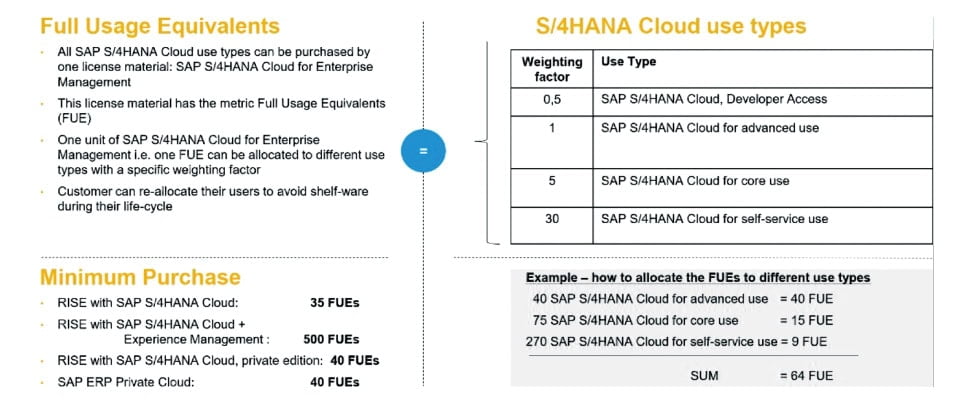FUE: Estimate for new Rise-with-SAP contracts


With Rise with SAP, SAP licenses are no longer purchased but leased (subscription). This means that customers no longer acquire a right of use for life, but after the contract term, the right of use expires abruptly, or you must conclude a contract renewal under modified conditions.
If you look at the structure of future costs (rent per year), you will notice that user licenses are still the largest single item. However, you no longer rent individual user license types, but so-called Full Use Equivalents (FUEs). At first glance, this is a relief, as you do not have to estimate the exact number of individual user license types before use. At second glance, however, you still have to estimate how many FUEs you will use per year in the future. This is just as difficult as it used to be with R/3 (ECC) or S/4 (on-prem).
User license types
There are four user license types in the cloud, which are assigned different solution functions:
- SAP S/4 Hana for Advanced Use: The user to whom this user license has been assigned may use all solution functions, just like the Professional User at that time.
- SAP S/4 Hana for Core Use: This is particularly interesting for sales and service organizations. Users who have been assigned this user license may only use the solution functions to a limited extent. In particular, they may not use any solution functions from the Finance area.
- SAP S/4 Hana for self-service use: This user license is the most restricted. However, it allows read access and authorizations can be granted with it. This user license type is particularly interesting for the manufacturing industry.
- SAP S/4 Hana for Developer-Use: The user to whom this user license has been assigned may use the developer tools.
The graphic shows how FUEs are calculated. As you can see, it is still important to classify the SAP Core usage of each individual user. The question is how to get the sufficient number of FUEs to run your future Rise-with-SAP cloud environment.

SAP S/4 Hana Cloud Licensing. Licensing user access to digital core via full usage equivalents. (Source: SAP)
Guido Schneider, SLC365What do you think, Myrja, of the idea of converting your existing user license inventory one-to-one via a table? For example, a professional user license for an FUE?
Myrja Schumacher, HonicoIf you have too much money, you can do it this way. Before migrating, you should get rid of any shelfware. Possible over-licensing would continue in the cloud. Anyone who was still measured on a usage basis in ECC could be measured according to authorizations in the future with S/4 Hana; anyone who does not deal with this beforehand could potentially run into major compliance conflicts.
Gudio Schneider: I agree, that's not a good idea. When switching to the cloud, you should take the opportunity not to transfer licenses that are no longer required to the new landscape. SAP now offers a free service to determine requirements and therefore the number of FUEs. What do you think of the "S/4 Hana Trusted Authorization Review", SAP's star service, and would you recommend it?
Myrja SchumacherSAP has published its own set of license rules based on authorization objects in the form of an Excel file for the first time with the Star Service. This could form the basis of an SAP remote audit in the future. However, in many respects it is, let's call it "fuzzy". An SAP_ALL user is incorrectly classified as "Functional Use" because the Star rules do not recognize sub-profiles. If the call is made via engine functionality, SAP often classifies a use license. This is inconsistent with the SAP price list: Only when core functionality is actually used outside an engine is a user license required. For these reasons, you should not rely 100 percent on the Star Service. S/4 Hana Trusted Authorization Review (Star) calculates both too expensive and too cheap user license types.
Gudio SchneiderIs there also a way to perform this S/4 Hana Trusted Authorization Review classification without SAP? And, if so, what would be the advantages?
Myrja Schumacher: This option is available. You can also use the Star Service without the support of SAP via the note (me.sap.com/notes/3113382). The result is the classification of roles, but with all the disadvantages described above. Then you have to start the system measurement program (transaction USMM), select the corresponding price lists and assign the corresponding license materials manually. The USMM determines the required license type based on the existing role classifications. The prerequisite for this is that no license type is entered in the user master (SU01). The individual account licenses are consolidated in the LAW. The FUE requirement is then determined manually according to the weighting factors, see above.
Gudio Schneider: In my E3 article (Usage-based versus entitlement-based user licensing, February 2024, page 18) you can read that I am critical of entitlement-based user licensing. The conversion to FUEs does not change this. Accordingly, a tool should be used to determine the number of FUEs, which automatically assigns the future solution functions in S/4 based on the actual use under ECC and thus simulates the license requirement. With this result, you then look at the SAP price and conditions list (PKL) and look for the next higher discount level. In many cases, it makes commercial sense to rent the number of FUEs at the next higher discount level, as this is more cost-effective on the one hand and can also absorb future changes in usage on the other. What do you think of this method?
Myrja Schumacher: I am no longer quite so opposed to authorization-based measurement. I completely agree with you that authorization-based measurement has no place in ECC. I agree with you that I have not yet read in any contract that licensing in S/4 is to be based on authorizations. However, there is a risk that SAP will base its measurement tools more and more on existing authorizations. In order to be prepared for this, it makes sense to examine the existing authorization concept from a licensing perspective. Which authorization object is used at all, what makes this role an advanced use type? It is often only a single authorization object that makes the role more expensive. Finding out whether this object was used at all and by whom is the trick!
A tool can be used to monitor the use of authorization objects within the roles and adjust the roles accordingly. This could also affect the usage type of the roles, for example by downgrading a role from "Advanced" to "Core", which then reduces the FUE consumption. SAM tools can simulate different scenarios for the existing SAP customer and then automatically write back the best results. A tool such as Dynamic License Control from Honico is also able to automatically resolve inconsistencies between engine usage and user classification. Transactions are also no longer sufficient for the future; Fiori applications are being used more and more and these need to be tracked, which is of course also best done with a SAM tool. If you have analyzed all this for yourself and also know where the company is heading in the future, then it often makes sense to use the next higher price level, see above.
Guido SchneiderThank you, Myrja, for your assessment and explanation. In addition to optimizing the star results using a tool, I also see the possibility of performing the FUE determination based on usage. In my opinion, SAP customers still have the choice on which basis they want to make the FUE estimate.
To the partner entry:





